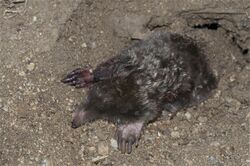Biology:Townsend's mole
| Townsend's mole[1] | |
|---|---|

| |
| Scientific classification | |
| Domain: | Eukaryota |
| Kingdom: | Animalia |
| Phylum: | Chordata |
| Class: | Mammalia |
| Order: | Eulipotyphla |
| Family: | Talpidae |
| Genus: | Scapanus |
| Species: | S. townsendii
|
| Binomial name | |
| Scapanus townsendii (Bachman, 1839)
| |

| |
| Townsend's mole range | |
The Townsend's mole (Scapanus townsendii) is a fossorial mammal in the family Talpidae, and is the largest North American mole. It was named after the United States naturalist John Kirk Townsend.[3] The name was selected at the request of Thomas Nuttall as a patronym to honor Townsend's contribution.[4][3]
Distribution and habitat
It is found in open lowland and wooded areas with moist soils along the Pacific coast from southwestern British Columbia to northwestern California . This animal's total range in Canada is estimated to be 20 km² (7.7 sq mi).
Conservation
Townsend's mole is classified as Least Concern by the IUCN; however, in Canada it is considered an endangered species.[5]
Description
It has velvety black fur, a pointed snout and a short, thick, a tail with barely any hair. It is about 21 cm (8.3 in) in length including a 4 cm (1.6 in) tail, and weighs about 138 grams (4.9 oz). Its front paws are broad and spade-shaped, specialized for digging; the rear paws are smaller. It has 44 teeth. Its ears are not visible and it has small eyes. It is similar in appearance to the smaller coast mole.
Behavior, diet, and breeding
Townsend's mole spends most of its time underground, foraging in shallow burrows for earthworms, small invertebrates and plant material. It is active year-round. It is mainly solitary except during mating in late winter. The female has a litter of two to four young in a deep burrow.
References
- ↑ Hutterer, R. (2005). Wilson, D.E.; Reeder, D.M.. eds. Mammal Species of the World: A Taxonomic and Geographic Reference (3rd ed.). Johns Hopkins University Press. pp. 302. ISBN 978-0-8018-8221-0. OCLC 62265494. http://www.departments.bucknell.edu/biology/resources/msw3/browse.asp.
- ↑ Hammerson, G.; Cannings, S. (2008). "Scapanus townsendii". IUCN Red List of Threatened Species 2008. https://www.iucnredlist.org/details/41475/0. Retrieved 20 July 2013.
- ↑ 3.0 3.1 Bachman 1839, p. 58.
- ↑ Carraway, Alexander & Verts 1993, p. 6.
- ↑ "Species at Risk Public Registry: Townsend's Mole". http://www.sararegistry.gc.ca/species/speciesDetails_e.cfm?sid=142.
Sources
- Bachman, John (1839). "Description of several new species of American quadruped". Journal of the Academy of Natural Sciences of Philadelphia 8 (60): 57–74. https://www.biodiversitylibrary.org/item/79280#page/61/mode/1up. Retrieved 10 December 2014.
- Carraway, Leslie N.; Alexander, Lois F.; Verts, B. J. (23 April 1993). "Scapanus townsendii". Mammalian Species 434 (434): 1–7. doi:10.2307/3504286. http://www.science.smith.edu/msi/pdf/i0076-3519-434-01-0001.pdf. Retrieved 15 December 2014.
Wikidata ☰ Q1767406 entry


